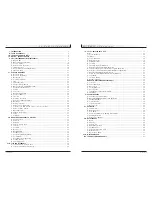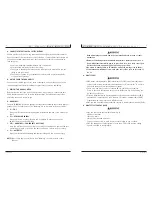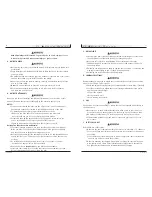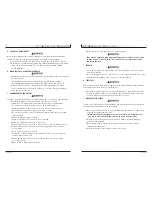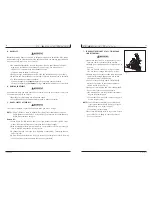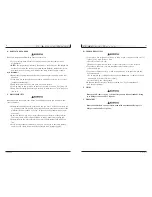
930466 Rev. A
V I . G e n e r a l W a r n i n g s
17
O. REACHING OR LEANING
Reaching or leaning affects the center of balance of your chair. If done improperly, a fall
or tip-over is likely. When in doubt, ask for help or use a device to extend your reach.
To Reduce the Risk of injury and/or Damage to the Chair:
1. Never reach or lean if you must shift your weight sideways or rise up off the seat.
2. Never reach or lean if you must move forward in your seat to do so. Always keep
your buttocks in contact with the backrest.
3. Never reach with both hands (you may not be able to catch yourself to prevent
a fall if you lose your balance).
4. Never try to pick up an object from the floor by reaching down between your knees.
5. Never put pressure on the footrests while reaching. This may cause the chair to
tip if you lean too far.
6. Never reach or lean over the top of the seat back. This may damage the backrest
and cause you to fall.
IF YOU MUST REACH OR LEAN; DO SO AT YOUR OWN RISK.
Remember to:
1. Move your chair as close as you can to the object you wish to reach.
2. Rotate the front casters until they are as far forward as possible. This makes the
chair more stable.
NOTE–
To do this: Move your chair past the object you want to reach, then back up
alongside it. Backing up will rotate the casters forward.
3. Turn off all power to your chair. If you fail to do so, you may touch the joystick
and cause your chair to move when you do not expect it.
4. Firmly grasp a rear wheel or an armrest with one hand. This will help to
prevent a fall if the chair tips.
P. DRESSING OR CHANGING CLOTHES
Be aware that your weight will shift if you dress or change clothes while seated in this
chair. To make the chair more stable, rotate the front casters until they are
forward
.
V I . G e n e r a l W a r n i n g s
930466 Rev. A
16
M. CENTER OF BALANCE
The point where this chair will tip forward, back, or to the side depends on its center
of balance and stability.
The Center Of Balance Is Affected By:
1. The seat height and seat angle.
2. A change in your body position, posture or weight distribution.
3. Using this chair on a ramp or slope.
4. The use of a back pack or other options, and the amount of added weight.
5. Drive wheel positioning.
To Reduce The Risk Of A Fall Or Tip-Over:
1. Consult your supplier for information on modifications authorized by Sunrise
before you modify or adjust this chair.
NOTE–
You may need to make additional changes to correct the center of balance.
2. Use extreme care until you know the balance points of this chair and how to
avoid a fall or tip-over.
N. TRANSFERS
It is dangerous to transfer on your own. It requires good balance and agility.
Be aware that there is a point during every transfer when the wheelchair seat is not
below you. To avoid a fall:
1. Always turn off power before you transfer to or from your chair. If you fail to
do so you may touch the joystick and cause your chair to move when you do
not expect it.
2. Make sure motor locks are engaged. This keeps the chair from moving when
you transfer.
3. Work with your health care professional to learn safe methods.
•Learn how to position your body and how to support yourself during a transfer.
•Have someone help you until you are sure you can do a safe transfer
on your own.
4. Move your chair as close as you can to the seat you are transferring to.
If possible, use a transfer board.
5. Rotate the front casters until they are as far forward as possible.
6. Be careful of the footrests. If you can, remove or swing them out of the way.
•Never stand on footrests when you transfer. Doing so may damage them or
cause your chair to tip.
•Make sure your feet do not “hang up” or get caught in the space between the
footrests.
7. Make sure armrests do not interfere.
8. Transfer as far back onto the seat surface as you can. This will reduce the risk
that you will miss the seat or fall.
Содержание Quickie P-222
Страница 28: ...N o t e s 930466 Rev A 54...



